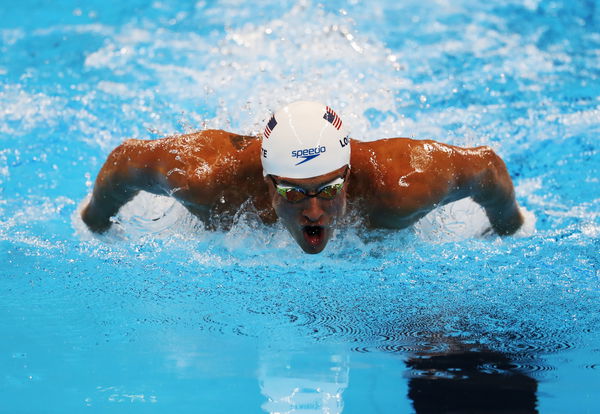
via Getty
RIO DE JANEIRO, BRAZIL – AUGUST 10: Ryan Lochte of United States competes in the heats of the Men’s 200m IM on Day 5 of the Rio 2016 Olympic Games at the Olympic Aquatics Stadium on August 10, 2016 in Rio de Janeiro, Brazil. (Photo by Ian MacNicol/Getty Images)

via Getty
RIO DE JANEIRO, BRAZIL – AUGUST 10: Ryan Lochte of United States competes in the heats of the Men’s 200m IM on Day 5 of the Rio 2016 Olympic Games at the Olympic Aquatics Stadium on August 10, 2016 in Rio de Janeiro, Brazil. (Photo by Ian MacNicol/Getty Images)
The World Aquatics Swimming World Cup comes with the opportunity for the swimmers across the world to showcase their prowess. Before the pandemic, the Swimming World Cup was arranged in three clusters. As many as seven three-day competitions were spread across seven locations. The event came with a good amount of prize money as well. In 2022, the total prize money was $1.2 million, meaning each of the winners received $112,000 on average. While the World Aquatics Swimming World Cup 2023 will raise its curtains shortly, it will have interesting new additions to it.
For the first time in history, the World Aquatics Swimming World Cup will feature the “open” category. In this, swimmers irrespective of their assigned gender at birth will be eligible to compete. It will also be a qualifier for the 2024 World Championships and also the Paris Olympics. Keeping all these in mind, Let’s delve into the history of the prestigious event.
ADVERTISEMENT
Article continues below this ad
Early days of FINA
FINA, or The Fédération Internationale de Natation, has been the sole governing body in aquatic sports. The Federation has a rich history that dates back to its inception in 1908. According to the official portfolio at the time of its formation, FINA disciplines comprised swimming, diving, water polo, open water swimming, and artistic swimming. High diving later found its place on the list in 2013 and was first introduced into the FINA World Championships that year.

The Fédération Internationale de Natation is headquartered in Lausanne, Switzerland. The organization however was founded in London with eight members initially. Eight European nations came forward to form FINA to meet the growing demands for a responsible aquatic governing body.
During those early days, the organization was involved in activities like creating the Officials’ list for the Olympic Swimming events or forming the FINA International Water Polo Board in 1928. FINA’s pioneering work has changed the face of swimming, especially the Olympics. The organization recommended that swimming and diving events must take place in separate pools. That has become a norm, similar to their proposal for using the indoor pool for Olympic swimming events. However, the Federation first came into its own in 1988, when the first FINA Swimming World Cup was held.
The first edition of the FINA Swimming World Cup
The FINA Swimming World Cup was held for the first time ever in 1988. Since its first edition, the event has only been held every year between the months of August and November. The World Cup attracts many talented swimmers to try their luck and win substantial prize money. The 25-meter short course pool has been the staple for this event except in a pre-Olympic year when the races take place in the 50-meter pool. Thus, this year, the World Aquatics Swimming World Cup 2023 will use the latter as the 2024 Paris Olympics will also feature a 50-meter pool.
Since its formation, the FINA Swimming World Cup has allowed the swimming paragons to take part in consecutive meets. Unlike the World Championships or the Olympics, there is no qualifier for the World Cup. Any swimmer can take part and try their luck for the incredible prize money on offer. Over the years, the format of the World Cup has changed quite a bit, as has the organization’s outlook. But the biggest overhaul happened in 2022 when FINA changed its identity.
The rebranding of the organization
The saga of the swimming World Cup history would be incomplete without mentioning the rebranding of FINA in 2022. FINA changed its name to World Aquatics to fit its new vision of “A world united by water, for health, life and sport”. The organization has rebranded itself for the future of all aquatic sports. This way, the organization hopes to bring more audience engagement to aquatic sports.

To vote on this new identity Federation assembled at the Extraordinary Congress in Melbourne on 12th December 2022. The brand new World Aquatics logo involves five lines that signify the five continents. The six circles display the disciplines. Besides, the eight blue bars symbolize each individual involved in the swimming world. The World Aquatics Swimming World Cup 2023 will be the first time that this logo will feature during the championships.
ADVERTISEMENT
Article continues below this ad
2023 World Aquatics Swimming World Cup
World Aquatics has declared the three-meet schedule for the World Aquatics Swimming World Cup 2023. The event will start in the first week of October on the 6th. The schedule for the 2023 World Aquatics Swimming World Cup is as follows:
- 6-8 October: Berlin, Germany
- 13-15 October: Athens, Greece
- 20-22 October: Budapest, Hungary
ADVERTISEMENT
Article continues below this ad
World Aquatics is yet to declare the prize money for the 2023 event. While speculation around this continues, excitement for the event also builds up. The World will look eagerly to it as the best swimming talents of the world storm up the pools in the hope of the upcoming Olympics in Paris.
Watch This Story: A Look at the Impeccable Performances of USA’s Power Swimmers Katie Ledecky and Katie Douglass in the World Aquatics Championship 2023
ADVERTISEMENT
ADVERTISEMENT
ADVERTISEMENT
ADVERTISEMENT

